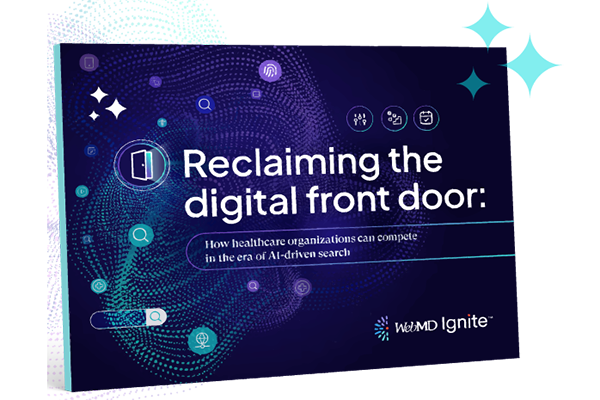Editor's Note: This blog was published prior to the transition to WebMD Ignite.
Think back to the last time you had an outstanding customer experience. Maybe you received the wrong item you’d ordered online, called customer service, and had the correct item delivered to your doorstep the next morning. Maybe your flight got delayed by several hours and you received a voucher for a free flight the next time you booked with that airline.
In today’s customer-centric marketplace, these types of stories are not uncommon. With the majority of companies already competing mainly on the basis of the customer experience, it is no longer optional to provide customers with exceptional service: According to a recent study by Aberdeen Group, companies with the strongest customer engagement and experience strategies retain an average of 89% of their customers, as opposed to 33% for companies with weak strategies.
Now think back to your last experience as a patient. Chances are you waited more than a couple of minutes to see your doctor and, when you finally got into the exam room, you had to repeat all of the information you’d already given about your illness over the phone.
Shifting to patient-centric approaches
It’s no secret that health systems have historically failed to live up to patient expectations, with patient-centric approaches to care falling by the wayside as hospitals have instead focused on how to reduce costs and improve their bottom line.
However, with the shift from volume- to value-based care, healthcare organizations must now update their priorities in order to remain competitive in the marketplace. According to a recent study conducted, 81% of consumers are unsatisfied with their healthcare experience — and the less they interact with the system, the happier they are.
Clearly, the healthcare industry has some catching up to do – especially when compared with retail and other direct-to-consumer industries. Considering healthcare’s inherently personal character, a solid engagement and customer experience strategy is especially critical.
Let’s take a look at the patient engagement journey and explore why it’s so critical for driving patient satisfaction throughout the entire continuum of care:
What is the patient journey?
The patient journey is the chain of interconnected events that a patient experiences when they first begin engaging with a certain healthcare system or across providers. This journey can include many activities, ranging from regularly scheduled appointments to engagement with certain marketing assets.
Every health system wants to encourage patient engagement, but not every health system understands that the path to patient engagement fluctuates depending on a patient’s past, present, and future activities. While patient engagement does take place during a single encounter, engagement shouldn’t be limited to that one encounter alone.
Instead, health systems should be thinking about the ways in which they can drive engagement throughout the entire patient journey. This means everything from the early education and awareness stage (for example, going online and searching for information on symptoms) to physician interaction to appointment follow-ups and reminders for continued care.
Understanding patient engagement as a multi-stage journey
In today’s healthcare landscape, consumers have more options, choices, and responsibilities when it comes to managing their own care. This ecosystem shift means that the patient journey is not a linear one, but rather a multi-stage journey with many different channels and touchpoints along the way (much like a tree with many different branches).
The phases of the patient engagement journey include the following:
- Awareness: Self-assessment of conditions and symptoms, leading to online research and education, posing questions on social media, etc.
- Help: Initial contact with health systems via the contact center, email, mobile, etc. (i.e., Who do I contact?, Where can I find it?, How can I ask a proper question?)
- Care: Assessment of health conditions in a medical facility (physician’s office, hospital, etc.)
- Treatment: On-site and follow-up care (medications, physical therapy, etc.)
- Behavioral/Lifestyle Change: Changes to reduce readmissions and promote proactive health
- Ongoing Care/Proactive Health: Ongoing care management between patient visits, fostering engagement between the patient & physician and enabling the patient to better manage his/her own care
It’s important to note that patient engagement is not a static journey, but one that should continue to evolve over the lifetime of a patient. For many health systems, this represents a very different construct for thinking about patient treatment – in other words, engagement does not begin and end with a single encounter.
How can health systems prioritize engagement in the patient journey?
With today’s more informed consumer comes a significant challenge for healthcare organizations: How do they effectively reach and engage patients on the channels they prefer to use (i.e., social media, digital, mobile, email, phone, direct mail, etc.)?
The key is to provide a personalized journey, that’s hyper-targeted towards each individual patient. Active patient engagement involves engaging consumers based on specific information (demographic, psychographic, social, behavioral, etc.), all of which can be managed with a healthcare CRM solution.
Armed with this information, healthcare organizations can build, launch, and manage multi-channel campaigns to target specific demographics, consumers at risk, consumers with specific conditions, etc. to effectively engage patients in their own care.
What’s more, health systems need to understand at what stage patients are in the “engagement tree” (i.e., awareness, treatment, etc.) in order to increase the likelihood of that person becoming and staying engaged. This involves measuring patient interaction points with health analytics, helping to anticipate patient needs, assessing what issues they might have with their current care, and crafting messaging strategically so it’s relevant to the individual.
How to create a high-quality patient engagement journey
Patient journey mapping is a useful strategy to employ during the build-out of any healthcare engagement campaign. As mentioned, the patient journey happens in six distinct stages: It begins with awareness – the moment the patient develops symptoms or becomes motivated to pursue medical treatment – and, in an ideal scenario, never entirely ends. The patient remains engaged with the system throughout treatment and during the ongoing and preventative care phases, with a continual stream of communication reinforcing loyalty throughout the cycle.
For this reason, a personalized or hyper-segmented approach is essential to mapping patient engagement. By tracking the many pathways throughout the engagement cycle based on service line, patient demographics, or market segment, healthcare marketers and providers alike gain a more thorough understanding of care priorities and opportunities for ongoing communication.
For example, a young healthcare consumer might appreciate email reminders, but will ignore most incoming phone calls from your health system. On the other hand, an older consumer might prefer phone calls and not regularly check their emails. With this approach, patients also become more invested in their long-term health and wellbeing and healthcare providers have a better opportunity to engage.
Final thoughts
As consumers become more discerning than ever before, fostering patient engagement isn’t just a best practice – it’s critical. Hospitals need to do more than just promote engagement during a single encounter: They need to find ways to engage patients throughout the entire continuum of care, maintaining regular communication and providing content, resources, and reminders to foster an ongoing relationship. After all, those consumers with a consistent relationship with a PCP cost the system one-third less.
What’s more… Healthcare consumers want to be engaged!
In fact, a recent study found that nine out of 10 patients would like providers to make preventive care recommendations. The study went on to find that three out of four patients agreed with the statement “I wish healthcare providers would communicate with me more often between appointments.”
The end result is, of course, patients who more proactively manage their own care — and health systems that empower them to do so. It’s a win-win.





